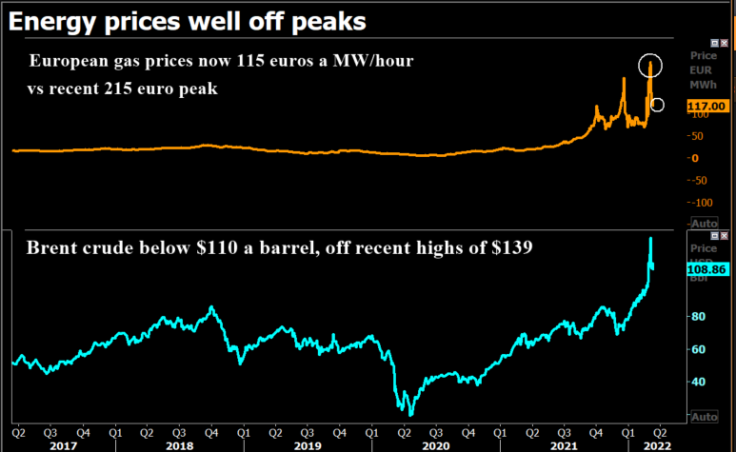Ukraine Peace Hopes Lift Stocks, Smack Oil Prices Lower

Tentative hopes of progress in peace talks between Ukraine and Russia lifted European shares and Wall Street equity futures on Monday, though upcoming central bank meetings and another COVID-linked lockdown in China eroded some of the early gains.
Russian missiles hit a large Ukrainian base near the border with Poland on Sunday, but both sides gave their most upbeat assessment yet of prospects for talks, with a Russian delegate quoted as saying there could soon be draft agreements
"If fighting stops that will be a step in the right direction as it will take more negative potential implications off the table," said Mizuho senior economist Colin Asher.
But the backdrop, with geo-political problems and central banks on the rate-rise path, meant that "for stock markets, the downside is the path of least resistance, at least in the near term", Asher added.
Some of the early positive sentiment ebbed, with a pan-European equity index and German shares ceding some earlier gains to stand 0.7% and 1.7% higher respectively by 1200 GMT.
S&P 500 futures which had earlier gained almost 1% were up around 0.3%, while Nasdaq futures slipped into the red
Brent crude futures fell $4 a barrel and European gas prices were at 120 euros per megawatt hour, almost 100 euros below recent peaks
The rouble gained 12% in thin-volume offshore trade, to 118 to the dollar.
Earlier in Asia, the mood was more subdued after a jump in coronavirus cases prompted the southern Chinese city of Shenzhen to tighten curbs.
Tokyo's Nikkei rose 0.6%, but Asia-Pacific shares outside Japan were dragged down by a hefty 3% fall in Chinese blue chips.
With cases still rising across China, lockdowns spell bad news for global supply chains, already under stress from the Ukraine war, with shortages of crude oil, industrial metals, semiconductor components and other key items.
"The improvement in global supply chains has ended before it ever really began," ING Bank economists Inga Fechner and Rico Luman told clients.
WEEK OF CENTRAL BANKS
Bonds remained under pressure as surging commodity prices fanned fears of an acceleration in inflation. Last week's hawkish signal from the European Central Bank also indicates policymakers will stay the course on raising interest rates.
German short-dated yields rose 4-5 basis points on the day.
U.S. Treasury yields shot higher <US10YT=RR>, with 10-year yields hitting 2-1/2-year highs of 2.106%. A measure of U.S. inflation expectations climbed to 3% and near record highs.
All that cements expectations the Federal Reserve will lift rates by 25 bps this week and signal more to come through "dot plot" forecasts of its policy-makers.
"The dots will likely be mainly clustered around four or five hikes for 2022, up from three previously, given the stronger pace of inflation since the January FOMC meeting," said Kevin Cummins, chief U.S. economist at NatWest Markets.
The Bank of England too is expected to lift rates by 25 bps on Thursday, the third rise in a row .
With six or seven Fed hikes priced for this year, the U.S. dollar stayed near its highest since May 2020.
The euro rose half a percent to $1.096, boosted by the hopeful signs on the Ukraine front and the promise of ECB policy tightening. But it remains close to recent 22-month troughs of $1.0804.
The yen plumbed a new five-year low against the dollar, as rate hikes remain distant in Japan.
"Interest rates everywhere are going higher but Japan remains very much at the back of the queue. The Bank of Japan meeting this week will be one of the few central bank meetings where rate hikes are not discussed," Asher said.
"So it's not surprising dollar-yen is pushing higher."
Gold, another safe haven, slipped 1% to $1,964 an ounce off last week's $2,069 peak [GOL/].
Likewise, Brent was quoted at $108.8 a barrel, having traded as high as $139 earlier this month [O/R].
For a graphic on crude prices, click:

© Copyright Thomson Reuters 2024. All rights reserved.




















